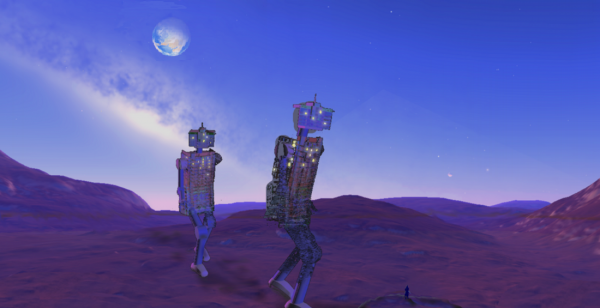BY LETTER
Mega-Mecha
Technology > Application > Infrastructure
Technology > Application > Megascale Engineering
Sophonts > Modosophonts > Sapient Structures
Technology > Application > Transportation > Surface Transport
Technology > Application > Megascale Engineering
Sophonts > Modosophonts > Sapient Structures
Technology > Application > Transportation > Surface Transport
Very large humanoid or animal-like mecha, often inhabited | |
 Image from Steve Bowers | |
| Giant mecha condos on Laurel | |
These extremely large mecha, often described as fantastic, awesome, and completely ludicrous, are indulgences, not practical vehicles. They typically start at 100 meters tall and have been as much as 1000 meters tall, and are generally utilized as walking homes, villas, or even cities for the materially ultra-wealthy and whimsical. In keeping with the whimsy that shapes them, "Mega-Mecha" are often sculpted to some aesthetic: flawless humanoids, mechanical spiders, giant turtles (with small worlds on their back), enormous fictional mecha of myth, and so on. (Large, legged transports would not normally be classified as "mecha" - like scrub slugs and walking cities on thousands of legs - are generally excluded from the "Mega-Mecha" category).
The appearance of Mega-Mecha is often created by a thin-walled facade. This is because the overriding engineering problem for Mega-Mecha is ground pressure. Even structures that are low-density by smaller standards (such as biological structures) would concentrate incredible pressure on a few contact points (feet) when scaled to 100 meters height. As a result, the titanic shapes of Mega-Mecha are little more than facades over minimal load-bearing frames and relatively tiny bands of Ultimate Muscle. The interior of Mega-Mecha thus tends to be mostly hollow spaces.
Secondary engineering concerns for Mega-Mecha include wind loads and stability. The tallest Mega-Mecha, like skyscrapers, are often subject to higher wind loads than loads from their own weight. Lacking the deep foundations of skyscrapers, they typically utilize the expedient of leaning into winds and other dynamic responses. Some worlds (such as Laurel) provide safe seating for large mecha during excessive winds.
Center of mass also tends to be lowered as much as possible, with heavy components like power plants and major "muscle" groups concentrated in the legs or lower torsos. Stability of the occupied spaces is another problem: true human-like bipeds produce a lot of vertical motion and sometimes horizontal sway to the torso and head (and, of course, the limbs), rendering those places unpleasant, even dangerous, to occupy while the Mega-Mecha is in motion. This is one reason that encourages non-humanoid bodyplans, such as 4-, 6-, and 8-legged insects that suspend a stable body between the multiple legs. Bipeds with human-like bodyplans must adopt unusual gaits or isolate habitats in motion-compensating sections (heads on stabilized necks are popular) to avoid battering the occupants.
The large amount of open volume tends to suit owners, who can fill the giant, building-sized Mega-Mecha with all manner of spacious housing, atria, dining halls, overly-elaborate control centers, and whatever else entertains the owners and occupants. Styling varies enormously and is often baroque and overdone (typical of the psychologies that build Mega-Mecha). "Steampunk" styling sees some adherents, but are often derided from within the steampunk community because Mega-Mecha only work with sizable quantities of advanced technology.
Various incarnations of Mega-Mecha date almost to the Information Age, but they were so rare and individualized that they were not grouped together as a class of vehicles until the Steppes Debacle.
Related Articles
Appears in Topics
Development Notes
Text by Mike Miller
Initially published on 20 February 2014.
Initially published on 20 February 2014.






